

Vol. 40 (Issue 40) Year 2019. Page 23
MAKUSHKIN, Sergey A. 1
Received: 19/06/2019 • Approved: 10/11/2019 • Published 18/11/2019
ABSTRACT: The topicality of investigating the issue is attributed to the growth of competition in all markets under conditions of globalization, the development of large structures on the market, the lack of highly qualified personnel. The purpose of the article is to uncover motivational processes that ensure the effective work of personnel at Russian enterprises in various fields. It is concluded that the mechanism of motivation used in a particular enterprise depends on certain factors, both external and internal. |
RESUMEN: La razón de investigar el tema se debe al crecimiento de la competencia en todos los mercados en condiciones de globalización, el desarrollo de grandes estructuras en el mercado, la falta de personal altamente calificado. El propósito del artículo es descubrir procesos motivadores que garanticen el trabajo efectivo del personal de las empresas rusas en diversos campos. Se concluye que el mecanismo de motivación utilizado en una empresa particular depende de ciertos factores, tanto externos como internos. |
Sustainable business development currently involves, among other things, the use of an effective system of personnel motivation as one of the important elements of enterprise personnel management. As an end result the motivation implies the growth in the productivity of the labor force through tangible and intangible incentives provided to employees by company management. Therefore, the formation of an effective motivational mechanism for employees, which will make it possible to achieve the company's main goals in business, primarily profit growth, becomes an important task of the management (Vesnin, 2015).
The main element in the functioning of any company is its employees. Employees (salaried employees and management) is the factor of production "labor", which works in business along with "land" and "capital" – the other two factors. The end result of activity, the achievement of organizational goals, objectives, and plans depends largely on the level and effectiveness of human resources (Jide, 2010; Hontsa, 2014).
As for the concept of motivation, for the first time the motivation was taken from the Latin word "move". Motivation is the cause of behavior (Isahrabiu, 2018). A person's motivation, conscious or unconscious, derives from his needs. Therefore, when determining motivation, it can be stated that motivation or need is an internal state, lack or deprivation that causes a person to do something. Another author defines motivation as the desire to make significant efforts to achieve the goals of the organization so that these efforts are aimed at meeting some personal needs (Robbins, 2000).
Motivation is a chain process that begins with a sense of need, lack or deprivation. It is accompanied by desire and leads to tension and action to the goal, the result of which is behavior of movement to the goal. The continuity of this process can lead to the satisfaction of needs. Therefore, motivation encourages and persuades people to do something. However, motivation reflects a common desire. The position of punishment and encouragement as strong motivation is clear in all studies (Wanjau and Kyongo, 2013). In this regard, the material component – money is considered as a tool of remuneration, but this is not the only motivational factor.
Using a standard method of personnel motivation, as a fixed salary, a manager cannot interest an employee to work effectively for greater efficiency. It is necessary to use several motivational factors (after all, a person has many needs and they are not always limited to material remuneration). An ineffective system of motivation leads only to temporary success, within the framework of the perspective given the high level of competition, an ineffective system of motivation leads to a loss in the form of turnover of highly qualified personnel due to the weak relationship between the interests of the company and its employees and socio-psychological tensions within the company (Ghanbarpour and Najmolhoda, 2013). The main task of effective s personnel motivation. Development and implementation of such a system that will interest every employee, regardless of his place in the hierarchical structure, to obtain a high personal result, which will naturally contribute to improving the performance of the company as a whole. There is no ideal motivation system at the present stage, a set of motivational tools used in the activities of companies often do not meet market requirements, all this requires the introduction of a more effective set of tools that form the system of personnel motivation in the company, alternative to the existing one.
Senior managers, often result-oriented, know that motivation with using an effective social package for employees is an indisputable element in attracting and maintaining the required level of human resources and in achieving the desired level of productivity necessary for the success of the organization. Based on the above, at the present stage of the country's development, the problem of personnel motivation acquires a very serious importance. Various aspects of this process are considered by many authors.
Problem of improving a motivational mechanism in Russian enterprises is raised by such authors as: E.A. Kolesnichenko (Kolesnichenko et al., 2017), M.V. Bespalov, I.Y. Radyukova, in their article the authors consider motivation as a function of personnel management.
The work of S.V. Ilchenko, E.V. Pavlova (lchenko and Pavlova, 2018) reviews the main elements of the motivation process and makes a bias towards the need to develop the components of the motivational mechanism.
Perhaps, at the present stage of development, there is an urgent need to consider personnel motivation, as a whole, taking into account basic theories of motivation, understanding of the term, basic methods and tools of motivation, as well as foreign experience in terms of existing models and their application depending on the industry, production processes at enterprise.
The theoretical significance of the study lies in complexity of the study of personnel motivation of in organization taking into account all the incoming elements.
Practical significance lies in the fact that the problem of personnel motivation at the present stage, in a rapidly changing external environment, determines the development of an existing one or the development of a new motivation mechanism for each enterprise depending on the direction of its activities and processes carried out. With this in mind, a practical study was conducted in a form of questioning, processing of questionnaires and summarizing the results, which is presented in the article.
The problem of personnel motivation raised by many authors, well-known economists. It should be noted. that in development of the theory of motivation a significant contribution was made by such authors as: F. Teolor, A. Foyol, G. Lawrence, P. Drucker (2003), H. Ford and others. With study of personnel motivation systems, evaluation of the effectiveness has been working such authors as: F. Herzberg, L. Porter, E. Lawler, S. Adams, and other authors. The study of issues related to improving efficiency of labor, means of motivation, both tangible and intangible, was done by such authors as: V.N. Grineva, M.S. Doronin (2013), S.I. Sotnikova, P.F. Repin (Repin and Eliferov, 2008), N.N. Oparina (2005) and many other authors. Table 1 presents basic theories of personnel motivation with the main provisions.
Table 1
Basic theories of
personnel motivation
Motivation theories |
Main provisions |
Restrictions |
Conventional F.U. Teolor G. Lowrence H. Ford |
High motivation involves rationing and labor organization, formation of uniform conditions of motivation, piecework wages. |
The basis is a material reward. Internal motivation is not taken into account. |
Meaningful: Theory of needs hierarchy A. Maslow |
Maslow’s theory of needs hierarchy argues that what motivates a person to perform certain functions or behave in a certain way is to satisfy some internal needs. These are physiological needs (food, air, sex, etc.), needs for security, and needs for social belonging, self-esteem and self-realization. According to him, these needs dominate in the conscious behavior of individuals at different stages of life, starting with the most basic. As soon as the first or immediate needs are met, they cease to dominate and give way to next needs in the hierarchy. |
Unclear designation of criteria for changing actualized needs; needs are not interchangeable, one cannot compensate the other. |
Theory of two groups F. Herzberg (Theory X and Y Motivation) |
Some factors in an organization are not necessarily motivators, but rather hygienic factors. By hygienic factors the author implies a salary increase, technical supervision, human relations, politics and administration of a company or organization; working conditions or physical environment and work safety. According to him, what really motivates an employee is his promotion in workplace, the trust placed in him by the management, making him responsible for the work, or putting some employees in his care. |
By studying a problem area survey was based on a specific category of personnel, the main point being to obtain a subjective assessment of bright events that were remembered in this workplace. In this situation, it is impossible to talk about the validity of claim that motivators can lead to |
McGregor (1985) also developed what he called the theory of motivation "X" and "Y" |
Theory X says that a person is by nature lazy, idle, self-centered, and different from organization. On the other hand, the theory of "Y" says that a person is not lazy and not idle, that all that is needed for an organization is to create a conductive atmosphere for work, and work will be as natural for him as a game or a rest. |
growth of job satisfaction for any group of workers. The level of optimal satisfaction of needs is also unjustified. |
Three-factor model D. McCleland |
Three factors (achievement, complicity, dominion) affect human behavior. Needs have varying degrees of manifestation. |
Lack of analysis of relationship and interaction needs of workers |
Procedural theory L. Porter E. Lawler |
The theory relies on description of the model based on five variables: effort, perception, results obtained, remuneration, degree of satisfaction. |
There is no clear priority. The main focus is problem of waiting, the fairness of remuneration. |
Justice theory J.S. Adams (1963) |
The ratio of remuneration and effort, the ratio of the remuneration of others (with similar work). |
It may be noted that factors are limited; the predictability of the situation of injustice is insufficient (Adams, 1963). |
The importance of personnel motivation problem characterizes a large number of studies, in this direction can be noted such authors as: A. Kibanov (2014), A. Kolota, S. Bandura, V. Zhigalov, N. Martynenko and many other authors. At the same time, the economic literature does not provide a holistic understanding of the nature of motivating employee process, the peculiarities of forming the employee's responsibility for the work he did, the formation of methods of motivation and methods of motivation (Sotnikova, 2003). Many scientists have proved the need for personnel motivation in the organization, but a unified approach has been developed and there was no universal approach applicable at any enterprise. Table 2 presents interpretation of "personnel motivation" concept by various authors.
Table 2
Interpretation of "personnel
motivation" concept
Author |
Meaning of concept |
N.V. Dikan (2008) |
He considers motivation as willingness of people to do everything possible to achieve organizational goals and to meet specific individual needs thanks to the ability of these efforts. The introduction of three key concepts (effort, organizational goals, and individual needs) is connected with this interpretation. |
Kibanov A.Y. (2014) |
Motivation is the promotion of certain human behavior due to tension between needs and ability to meet them. |
N. Dryakhlov and E. Kupriyanov (2009) |
These scientists interpret motivation as a motivation of people to active functioning: process of a person’s conscious choice of a certain line of behavior based on internal and external factors or, in other words, on motives and incentives |
Zalutskaya N.S. |
Motivation is presented as an aggregate of driving forces, both internal and external, encouraging to act, defining behavior and giving direction to activities, defining forms of activity, orienting to achieve goals, both personal and organizational (Zalutskaya, 2015). |
Titova S.V. |
She considers motivation as a process associated with the selection and justification of the method of human participation at an organization (Titova, 2016). |
Turchin D.M, Tsyrikova N.P. |
They consider motivation as a process affecting environmental factors, both production and social, under the influence of these factors, changes in human behavior occur, as well as the achievement of certain goals related to the improvement of production management mechanism and production process itself (Turchina and Tsyrikova, 2017). |
Khagur F.R. |
Motivation is presented as a set of reasons that encourage targeted action. It is also possible to call motivation an internal state that encourages, guides and preserves the desire of a person to achieve goals (Khagur, 2016). |
In general, it is necessary to note the complexity and diversity of the motivation concept requiring a comprehensive study of the issue. Similarly, this notion is represented by various concepts: a set of motives, a set of objective and subjective factors, a process of stimulation, internal and external driving forces, and much more (Kolesnichenko et al., 2018; Bezpalov, 2014).
Motivation can be presented as the main function of any administrator (manager), exactly this function helps to affect staff and its behavior at a company. The main elements of the motivation process should include: objects of motivation, subjects, external motivators, as well as a system of social factors (Ilchenko et al., 2015).
Objectives of motivation can be divided depending on the object: goals set by the employee; goals set by the organization. If we consider the latter, the main goal of motivation is to create a set of conditions that encourage employees to take actions, the main focus of which is maximum effect. From the point of view of the employee of the enterprise, the main goal of motivation is to provide for their personal needs. Accordingly, in the personnel motivation system, each of the parties has an interest in achieving personal goals (Ilchenko, 2017).
Main tasks of personnel motivation:
The main functions of personnel motivation can include:
The following key factors of motivation presented by T.A Filippova can be identified (Filippova, 2017):
The system of personnel motivation is formed by various methods, the choice of which by the organization is carried out independently (Borscheva and Ilchenko, 2017). The main methods that have an enlarged composition of the tools include:
The most common method is the material one represented by a variety of tools, the use of which in an organization can be carried out both in aggregate and separately. In this situation, we can talk about the following tools:
A fair level of material remuneration is a motivational factor for the initiative of employees while forming the commitment of this organization. It is also an attractive factor for new employees. Using the material method and tools of motivation will enable the company to achieve its goals and lead to the expansion of its capabilities.
It is also possible to use organizational methods for motivating the personnel of the enterprise, the main direction of which is to provide comfortable working conditions. In this situation, we can talk about the use of such tools as (Surat, 2015):
The moral and psychological method of motivating employees is the least expensive method compared to others, represented by such tools as:
This method of personnel motivation can also be attributed to the effective with the proper use of tools and the identification of core values and staff needs of enterprise (Surat, 2015).
Methods of motivation, namely the tools used in the framework of methods of motivation, can also be classified as positive and constraining. The positive ones were considered earlier; the following tools can be considered as constraints:
At the present stage, as well as before, both positive and deterrent tools are mainly used in order to prevent negative situations in the process of an enterprise’s activity. They are often called leverage in terms of staff motivation. The use of certain levers of influence is determined by the management of enterprise and is legally confirmed (Labour Code of RF, etc.) (Surat, 2015). It is possible to designate in the form of a scheme the main levers of influence (tools) according to a more detailed classification, with the main tools used (Figure 1).
Figure 1
The main methods and tools of personnel motivation of an organization
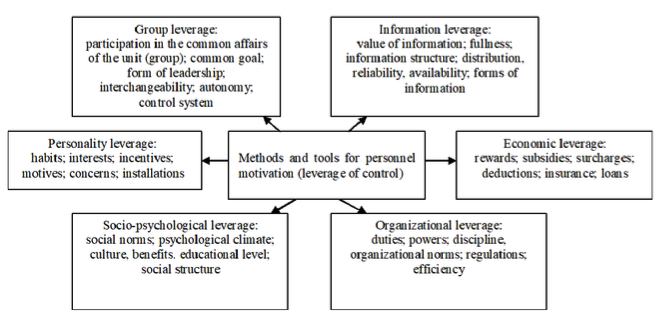
Source: compiled by the author on
the basis of materials (Zotkina et al., 2017)
Foreign experience is a quite interesting point in the study of personnel motivation is. At the present stage, within the framework of the active process of using European standards, many domestic organizations often form the basis for development of personnel motivation system to use successful foreign experience without taking into account the difficulty of not understanding features of the model and the need to adapt it for a particular enterprise. In this situation, there is a need to study and systematize the main aspects of personnel motivation in world practice (Table 3).
In this regard, it is very important to study and systematize the main aspects of the world practice of motivation and stimulation of labor activity.
Table 3
The main foreign models of personnel motivation
Country |
General characteristics of the motivation system |
The main factors of motivation |
Distinctive features of work motivation |
Japan |
The outpacing rates of productivity growth relative to the growth rates of living standards and wages. |
The main factors can include: seniority, age, labor productivity; professional skill. |
Distinctive features are the system of life-long employment (but in this situation, workers can be transferred to another position as horizontally and vertically too. |
USA |
The very foundation is material methods of motivation. Entrepreneurial activity is encouraged. |
Among other main factors the following can be listed: high qualification, entrepreneurial activity, quality of work. |
Distinctive features are: wages (piecework and time-based); awards for trouble-free operation, long-term operation of equipment and tools; adherence to technological discipline; double betting system; profit sharing. |
France |
Economic tools are widely used (including strategic planning in market mechanisms, promoting competition, flexible taxation). |
The following can be considered as key factors: high qualification; innovation proposals (quantity); quality of work; mobilization opportunities. |
Distinctive features are: a ball estimation of work (professional skill, quality, productivity); additional rewards; individual payment; initiative. |
Great Britain |
Modification of the wage system depending on profit. |
Main factor can be income. |
Distinctive features are: labor participation; equity participation; profit sharing. |
Germany |
A human is a free person who is aware of his social responsibility. |
Main factor can be quality. |
Distinctive features are: availability of social guarantees and labor incentive. |
Sweden |
Strong social policy aimed at reducing property inequality. |
Main factor can be solidary wage |
Distinctive features are: presence of a strong social policy; differentiation of the system of taxes and benefits. |
Source: compiled by the author on
the basis of materials (Gurova, 2017)
Within the framework of the information presented in the table regarding the models of personnel motivation, it can be noted that the Japanese model is considered the most flexible of all the other systems. However, its existence is built on the peculiarities of the national mentality, and requires from people a high degree of development of self-awareness, priority of public interests over personal ones, as well as readiness for certain “sacrifices” for the sake of general well-being, which is noted by I.М. Gurova (Gurova, 2017). In most Japanese organizations, material incentives are based on labor pricing of workers. Today, the so-called “synthesized wage system” is most common one where wages are formed taking into account four main factors (age, length of service, professional skills and labor productivity), and the basis for personal labor rates are age and length of service and the basis for determining labor tariff rate (“rates for qualifications”) is served by professional skill and labor productivity. Thus, the use of the labor rate is linked to the qualification and labor contribution of the worker, and as G.V. Alexandrov, which holds back automatic wage growth in connection with the indicators of "seniority" increasing the motivation to labor productivity (Alexandrov and Tseselskaya, 2017).
The American model considers the remuneration of labor as the basis of motivation system, which is based on certain social and cultural attitudes of the nation, i.e. orientation to achieve personal success and a high level of economic well-being of each person. The systems of material incentives for labor activity are represented here by various modifications of hourly wages with standardized tasks supplemented by various forms of bonuses. The advantages of the French approach are employees' awareness of economic situation of the company and a strong stimulating effect on efficiency and quality of work, which ensures self-regulation of the wage fund (if difficulties arise it is automatically reduced and the organization calmly experiences market changes).
The English system relies on two modifications of the system of remuneration for labor, depending on profit: monetary and joint-stock (intending partial payment in the form of shares), as well as the use of "fluctuating" wages, which depends entirely on profits of the organization. Such profit sharing, as noted by I.M. Gurova, positively affects both the organization itself and its employees, as it improves their attitude to work and stimulates the efficiency of labor resulting increased productivity (Gurova, 2017). As a result of their consideration it can be concluded that all of them have distinctive features, which is largely due to national characteristics. At the same time, among the various systems one can find a certain similarity of methods.
Figure 2
Process of motivation and
enterprise motivation policy
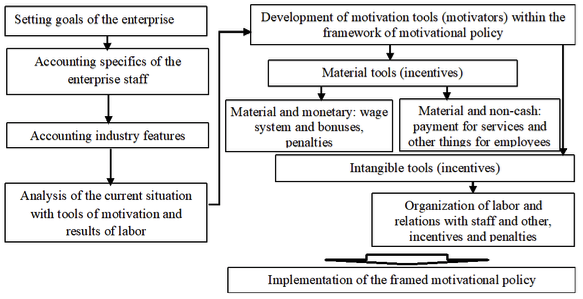
Source: compiled by the author
Summarizing results of literary sources analysis, it is possible to construct the following scheme reflecting the process of motivation and enterprise motivational policy (Figure 2):
In general, it can be said that personnel motivation at the present stage is one of the priority tasks within each company, which is why the company must formulate a motivational policy that meets the goals and specifics of the activity. The development and use of an effective system of personnel motivation and motivational policies including through the implementation of methods of material and non-material incentives for employees is the main condition for improving the efficiency of each enterprise increasing its competitiveness in the market.
For studying specifics of motivation and motivational policies at modern companies a small business segment was analyzed (with a staff of 15 to 100 people, that is, not a micro business) in the Ural Federal District of the Russian Federation. 10 enterprises working in the field of wholesale trade, 10 enterprises working in the field of production and 10 enterprises working in the service sector (transport, catering, cleaning) were investigated. All the organizations studied for greater comparability of data are located on the territory of large cities of the district (Yekaterinburg, Chelyabinsk, Magnitogorsk, Kurgan, and Tyumen). All organizations are active at the time of the survey. The sample was not representative; moreover, it was difficult to find managers who agreed to answer questionnaires, since the data on motivation and the use of personnel incentive methods are not open, are not published in statistical databases, and are not provided to everyone who applies for such information. The answers were received on condition of anonymity and non-disclosure of information about the system of motivation of each particular enterprise.
The main research method was to fill out a questionnaire and answer questions from the heads of organizations. According to the results of the survey processing was carried out and summarizing the results was determined, on the basis of which it was possible to draw a conclusion. Survey items were as follows:
In addition, the questionnaire contained questions about the industry sector and the number of employees of enterprises.
Considering the different industry specifics (in wholesale, the majority of workers are sales managers, in production they are workers, in services they are also mostly working personnel), data processing was carried out both in general and by industry, and the results are presented in graphs.
A survey conducted in January 2019 (during January, 10-31) made it possible to receive completed questionnaires, process them and present the results in February 2019.
The results of answers to the first questionnaire were as follows (Figure 3).
As appears from the above schedule, all wholesale trade enterprises participating in the survey apply piece-rate wages to the majority of workers, since wages depend on the sales volume of sales managers.
Figure 3
Distribution of answers to the question “What pay form is applied
in the enterprise mainly to a larger number of workers?”

Source: compiled by the author
For production, there is also a characteristic high proportion of piece-rate pay, since this stimulates workers to produce more jobs per shift; although there are also those productions where time-based wages are more commonly applied, taking into account the specifics of work. In the services sector, half of the surveyed enterprises use piece-rate and time-based systems, which are also explained by industry specifics. As a result, more than 76% of surveyed business entities chose piecework to motivates their employees to perform large volumes (sales, production, services), while insuring themselves against unnecessary cash expenditures during a decline in volumes. Application of awards at enterprises is presented in Figure 4:
Figure 4
Distribution of answers to the question “Do bonuses
accrue when performing certain indicators”

Source: compiled by the author
As appears from the Figure 4, in the wholesale trade, premiums are applied only in 40% of cases for surveyed enterprises, which is explained by piece-rate payment and management’s unwillingness to make payments to additional employees, even if there are some specific results achieved. Similarly, in the sphere of production, but there the share of enterprises with premiums is somewhat higher. In the services sector, the share of enterprises with premiums is even higher, which is also explained by the sector specificity of services and by the fact that they often use time-based wages and it is difficult to motivate staff for effective work.
Premiums can be a different share in employee benefits (in his remuneration), and in many enterprises, they usually set a low enough salary for incentives so that an employee is interested in improving his performance and can significantly increase his own income. The distribution of the surveyed enterprises by the share of bonuses in employee benefits is shown in Figure 5:
Figure 5
Distribution of answers to the question
“The share of the bonus in employee benefits is”
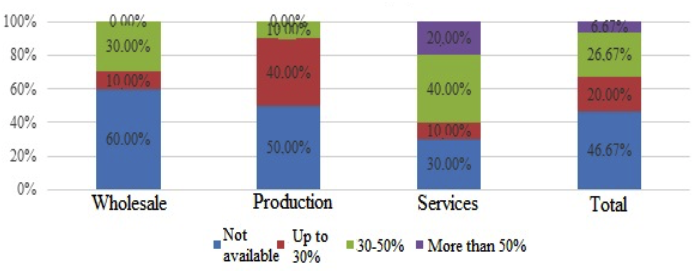
Source: compiled by the author
As can be seen from the data presented in Figure 5, in wholesale trade, where bonuses are applied, the share in employee benefits payments is often from 30 to 50% and this characterizes the piece-bonus system in this area, bonuses are paid for achieving certain management sales figures, level of arrears, etc. In production, mainly, the share of the premium, where it is, is up to 30% and in services – 30-50% too, but in 20% of the surveyed service companies pay more than 50% of the premium in total payments to employees (where work is built on a time-based wage system and indicators are set for workers, the implementation of which guarantees one or another level of bonus). In general, the bulk of the surveyed business entities pay bonuses of up to 30 or 30-50% of total employee benefits. For which achievements are paid bonuses Figure 6 presents:
Thus, in general, most of all surveyed companies accruing the premium accrue it for the personal results of each employee’s work and tasks assigned to him, to a lesser extent combine the personal achievements and achievements of the enterprise together, but he does not award principle.
Figure 6
Distribution of answers to the question
“The award is charged for the results of work”
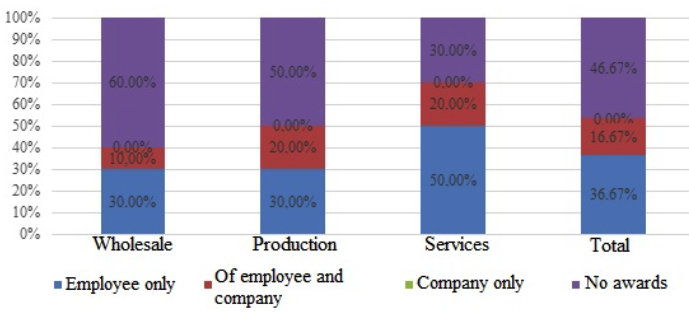
Source: compiled by the author
Therefore, personal achievement is the main factor of bonuses and income of the employee as a whole. Fines are also one of the most important material incentives having a “negative” character and are used mainly for violators of the labor regime, less often for those who do not fulfill the plan, etc. The application of fines in the surveyed enterprises is presented in Figure 7:
Figure 7
Distribution of answers to the question
“Does the company apply fines to employees”
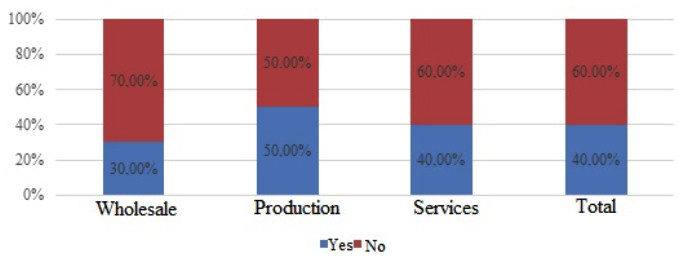
Source: compiled by the author
As can be seen, fines are used to a large extent by production enterprises (half of the respondents) and services (40% of the respondents) taking into account the specifics of their work and often a large amount of violations of internal regulations by employees. As for wholesale trade this share is significantly less (30%) and in general it makes up 40% of the surveyed business entities. The use of non-monetary rewards (non-monetary material incentives) is presented in Figure 8:
Figure 8
Distribution of answers to the question “Does non-monetary remuneration
apply to a significant part of employees (tuition, insurance, fitness, etc.)”
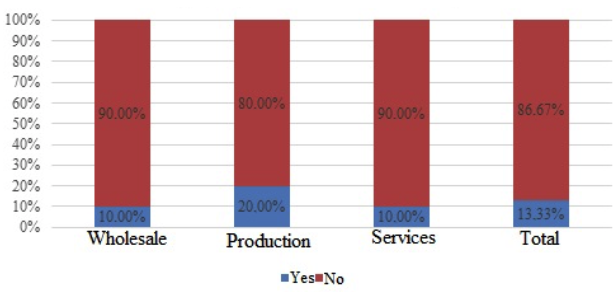
Source: compiled by the author
As can be seen from the presented data, only slightly more than 13% of all surveyed business entities use material non-monetary incentives, and to a greater extent – in production. This is not entirely rational, since it could retain more valuable specialists providing them in addition to cash bonuses also such methods of support and rewards.
Results of the answer to question on the use of intangible incentives are presented in Figure 9.
As can be seen from the data of Figure 9, 60% of all surveyed business entities do not use intangible incentive methods in principle, that is, they do not attach any importance to this tool for personnel motivation. In particular, in the wholesale trade (only 30% of enterprises use, and this is a personnel reserve, honor roll, etc.).
Figure 9
Distribution of answers to the question “Does the system
of non-material incentives apply and what is included”
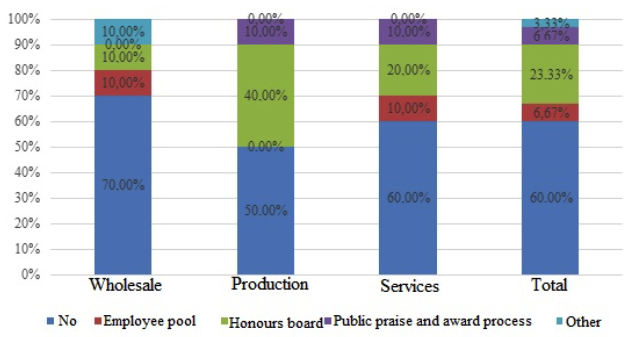
Source: compiled by the author
In production, as can be seen, the tools of non-financial incentives are already being used to a greater extent, and this is the hall of honor (on the model of large industrial enterprises) and public praise and rewarding. In the services sector these tools are also used to a lesser extent, but the personnel reserve, the honor roll, public praise and awarding are used.
According to the results of the study certain conclusions can be drawn that reflect the problems of personnel motivation among small businesses having limited resources to form effective personnel, including motivation, policies, unlike large and even medium-sized businesses that use motivation tools are often broader. Indeed, little value is given to bonuses. Bonus system is often either completely absent and staff receives piece-rate wages without bonuses, or it is chaotic and does not always reflect the actual development needs of the business.
At the present stage, the introduction of awards as a mandatory element is important because it provides opportunities for:
The use of fines in the practice of Russian not only small but also large business is also not an effective enough practice. The opinion that the fine is the same incentive as the premium, but negative (there must be no violation or non-fulfillment – then there will be no penalty) cannot be called justified. A fine is perceived by an employee not as an incentive but as a punishment. Punishment in practice does not always lead to “correction” and there may be doubts about its fairness, which, as a result, can only demotivate an employee to effective work. It would be much more correct to “differentiate the premium” (Karastelev and Babenko, 2017), setting it, for example, in certain sizes or percent for:
In this case, the employee will receive a higher premium if he fulfills certain requirements (if not, the bonus will be lower). Fines can only be left for serious violations. In this case, the fairness of the fines system should be much higher.
The problem is the lack of attention of employers in small business (which is typical in Russia and not only for small business) to material non-monetary incentives. Indeed, the provision of housing at the expense of the employer for valuable employees from other cities (rent for housing, which, in fact, is much lower than the salaries of qualified personnel), tuition fees (which can also be fixed by an agreement between the company and the employee, under which the employee undertakes to work at the enterprise a certain period), payment for sports activities, short-term trips to vacation spots in the region or even partial payment for vouchers or air tickets purchased from a tour operator (for legal entities, as a rule, tour operators or their agents can make substantial discounts) – all these are important points that will help both build trust between the team and the management and keep the right employees in place, encourage them to continue working for the benefit of the company (Evplova, 2013).
A similar problem is a very small focus on non-financial incentives in small business and yet it is an important tool for personnel motivation. Indeed, each person has a certain place in the hierarchy of values, which A. Maslow presented in his “pyramid of needs”. Initially, only earning is important for employees, but with stable work, and, especially, with high incomes, public recognition also becomes important for him, which is why such motivation tools as honor boards, public praises, groups in social networks or websites where they are published photos of employees, data on awarding and recognition of merit – all this is important for employees who feel valuable for their own enterprise, which, in particular, is noted in the article by S. Rychkov (Rychkov, 2018). Similarly, the availability of personnel reserve and work with him. A person can claim the head of department or deputy director and his inclusion in the reserve gives him a chance and hope for the future job in the company, rather than leaving it, and he will work more efficiently and be trained to be included in the personnel reserve and go on from it to the vacancy. In addition, the personnel reserve is used to fill the resulting vacancies, primarily in senior staff.
Failure to use the listed personnel motivation tools makes the motivational policy of the enterprise weaker than it could be.
Thus, personnel motivation is a socio-psychological process that contributes to the efficient work of employees. It is due to the presence of motivators (or "incentives") which can be considered primarily as material (these are monetary incentives, such as wages and bonuses, in some cases, fines, and non-monetary incentives associated with other remuneration in non-monetary form, payment of services for the employee at the expense of the employer, including insurance, communications, housing, business trips, fitness, etc.) and intangible (formed by the attitude of the management towards the employees, including a system of rewards and penalties, comfortable working conditions, involvement in process of enterprise management, etc.). Therefore, the implementation of these incentives is a process of stimulation. In the complex, the applied incentive motivators, the process of their application and the goals of application constitute the motivational policy of the enterprise, aimed at increasing labor productivity and retaining the most valuable employees at the same time. In each organization, a motivational policy is built in its own way, and it depends on the composition of personnel, region, level of salaries in the market, mentality (as a result of which in different countries common approaches to motivational policy may differ significantly).
A practical study of 30 small organizations (with a staff of 15 to 100 people) in the field of wholesale trade, services and production in the Urals Federal District (only for large cities) was conducted, resulting in the following main conclusions. In a significant number of cases, the enterprises studied use piecework for the majority of workers while bonuses are not used sufficiently, not paying attention to issues such as material non-monetary and non-financial incentives for staff, which cannot be noted as a positive result. The use of “negative” material incentives in the form of fines in many of the surveyed enterprises is also a rather dubious tool of motivation, which should be replaced to a greater degree by differential bonuses.
Adams, J.S. (1963). Toward an understanding of inequity. Journal of Abnormal and Social Psychology, 67, 422-436.
Alexandrov, G.V., Tseselskaya, E.V. (2017). Foreign experience in the field of enhancing staff motivation and retaining staff in the enterprise. Postulate, 6(20), 56-60.
Bezpalov, V.V. (2014). Diagnostics methods for purposes of restructuring of regional management system. Life Science Journal, 11(9 SPEC. ISSUE), 9, 56-59.
Borscheva, A.V., Ilchenko, S.V. (2017). Evaluation of the effectiveness of the personnel policy of the organization. Bulletin of Experimental Education, 4(13), 41-51.
Doronin, M.S. (2013). Socialization of the economy and labor potential of a production organization. Business Inform, 6, 214-220.
Drucker, P.F. (2003). Effective Management. Economic Tasks and Optimal Solutions. Moscow: Nauka.
Dryakhlov, N., Kupriyanov, E. 2009. Personnel motivation system in Western Europe and the USA. Problems of Theory and Practice of Management, 2, 83-88.
Dykan, N.V., Borisenko, I.I. (2008). Management. Kyiv: Znannya.
Evplova, E.V. (2013). On the issue of material and non-material motivation. PNiO, 2, 104-109.
Filippova, T.A. (2017). The use of employee motivation as an opportunity to increase profits. Tavrichesky Scientific Observer, 5(22), 91-94.
Ghanbarpour, Z., Najmolhoda, F.S. (2013). Contemporary theories of motivation in organizational leadership and behavior. International Research Journal of Applied and Basic Sciences, 6(1), 1-7.
Gurova, I.M. (2017). Foreign experience of motivation and stimulation of labor activity. Economy and Society: Modern Development Models, 18, 106-121.
Hontsa, T.O. (2014). Personnel Motivation of an Enterprise under Globalization. Retrieved from: http://conf.sfu-kras.ru/sites/mn2014/pdf/d01/s55/s55_011.pdf
Ilchenko, S.V. (2017). Organizational Behavior. Moscow: Moscow Institute of Economics.
Ilchenko, S.V., Kivit, E.A., Orishev, A.B. (2015). HR Policy of the Enterprise. Moscow: Sampoligrafist Ltd.
Ilchenko, S.V., Pavlova E.V. (2018). Labor motivation as a socio-economic basis for personnel management. Business and Design Review, 2(10), 7.
Isahrabiu, U. (2018). The role of personnel management and workers motivation in an organization. IOSR Journal of Business and Management (IOSR-JBM), 20(4), 22-32
Jide, I. (2010). Theories of personnel motivation in organisations. Multidisciplinary Journal of Research Development, 15(2), 1-10
Karastelev, A.A., Babenko, I.V. (2017). Human resource management in a small business. Politics, Economics and Innovation, 2, 3-10.
Khagur, F.R. (2016). The contribution of foreign scientists in the study of labor motivation. Bulletin of the Maikop State Technological University, 4, 121-125.
Kibanov, A.Ya. (2014). Methodology of motivation and stimulation of labor activity of the organization's personnel. Human Resource and Intellectual Resources Management in Russia, 3(1(10)), 5-10.
Kolesnichenko, E.A., Bespalov, M.V., Rodyukova, I.Yu. (2018). Improving the motivational mechanism in Russian enterprises. News of St. Petersburg State University of Economics, 5(113),149-154.
Kolesnichenko, E.A., Radyukova, Ya.Yu., Bespalov, M.V. (2017). Increasing the involvement of staff in the activity of the company as a factor influencing its efficiency. 30th IBIMA Conference (pp. 2170-2179). Madrid, Spain.
Oparina, N.N. (2005). KPI efficiency arithmetic. Human Resources Handbook, 12, 42-52.
Repin, V.V., Eliferov, V.G. (2008). Process Approach to Management. Business Process Modeling. Moscow: RIA "Standards and Quality".
Robbins, S.P. (2000). Organisational Behaviour (Ninth Edition). New Delhi: Prentice Hall of India.
Rychkov, S. (2018). Staff motivation according to Maslow’s pyramid of needs. Electronic Magazine "Commercial Director". Retrieved from: https://www.kom-dir.ru/article/2172-motivatsiya-maslou
Sotnikova, S.I. (2003). Competitiveness of staff as an object of management. Bulletin of Omsk University: Economy Series, 4, 68-75.
Surat, I.L. (2015). The main approaches to the development of higher education in the framework of project management. Science and Practice: The Integration of Knowledge. Materials of the International Scientific-Practical Conference (pp. 126-131). Moscow: Moscow Institute of Economics.
Titova, S.V. (2016). The distinction between the concepts of "labor motivation" and "labor stimulation". Questions of Economic Sciences, 2(78), 53-55.
Turchin, D.M., Tsyrikova, N.P. (2017). Motivation and stimulation of personnel employment. Human resource management: from tradition to innovation. A Collection of Materials of the All-Russian Scientific-Practical Conference (pp. 36-40). Moscow: FHBOU VO MHPPU. NYU VShE.
Vesnin, V.R. (2015). Personnel Management in Schemes. Moscow: Prospekt.
Wanjau, M.N., Kyongo, J. (2013). Contribution of motivational management to employee performance. International Journal of Humanities and Social Science, 3(14). Retrieved from: http://www.ijhssnet.com/view.php?u=http://www.ijhssnet.com/journals/Vol_3_No_14_Special_Issue_July_2013/26.pdf.
Zalutskaya, N.S. (2015). Comparative characteristics of research methods of labor motivation. National Association of Scientists, 5-1(10), 54-56.
Zotkina, N.S., Kopytova, A.V., Neklyudova, M.Yu. (2017). Labor motivation management tools: concept identification. Online Journal "SCIENCE”, 9(3). Retrieved from: http://naukovedenie.ru/PDF/51EVN317.pdf
1. PhD in History. Professor. Department of Personnel Management and Personnel Policy. Russian State Social University. Moscow. Russian Federation. E-mail: S_makin2009@mail.ru